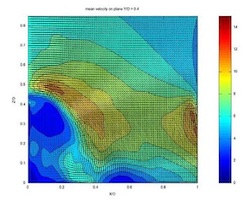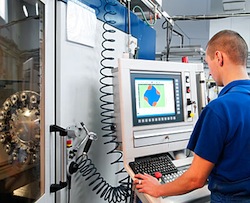DOE Grants Bring Advanced Modeling & Simulation to the “Missing Middle”
Last summer the Department of Energy’s Office of Science - Advanced Scientific Computing Research (ASCR) issued a call for grant applications under the DOE Small Business Innovative Research (SBIR) program. The topic’s title: “Increasing Adoption of HPC Modeling and Simulation in the Advanced Manufacturing and Engineering Industries.”
 The results are now in and they are impressive. (For example, this image shows computed averaged velocity fields from a VorCat wind tunnel simulation.)
The results are now in and they are impressive. (For example, this image shows computed averaged velocity fields from a VorCat wind tunnel simulation.)
This SBIR cycle is targeted to small- to medium-sized manufacturers (SMMs) that can employ high performance computing (HPC) enabled modeling and simulation (M&S) technology to solve a variety of tough manufacturing and engineering challenges.
The biggest challenge is to get the SMMs to use the M&S technology in the first place. Notes Dr. Daniel A. Hitchcock, ASCR associate director, “Despite the tremendous potential of modeling and simulation, HPC has yet to make significant inroads into the smaller manufacturing companies, the so-called ‘missing middle.’”
Hitchcock says that high on the list of factors slowing the adoption of M&S in this community is the level of expertise required to use the complex software. The purpose of the 2011 ASCRSBIR call was to facilitate in making the wealth of modeling and simulation software and tools developed by DOE labs and affiliated educational institutions available and usable to these manufacturers.
To this end, the grants cover three major categories:
- Turnkey HPC solutions for manufacturing and engineering
- HPC support tools and services
- Hardening of R&D code for industry use (“shrink wrapping” complex M&S solvers and tools developed by DOE so users with a lower level of expertise can use them)
Spreading the Word
The DOE SBIR team decided to be very proactive in getting the word out about the program and the grant structure. They took to the road, speaking at meetings sponsored by consortiums such as the National Center for Manufacturing Sciences NCMS) and the National Digital Engineering and Manufacturing Consortium (NDEMC), as well as at various regional and state-sponsored meetings focused on revitalizing American manufacturing.
The result was a gratifying response with many new companies applying for the SBIR grants.
“We were delighted to see how many of these organizations understood the opportunity to apply HPC to some really interesting problems – for example, wind turbines, catalytic converters, and constructing energy-smart buildings,” Hitchcock says. “The submissions dovetail nicely with DOE’s mission to promote clean energy and with ASCR’s charter to support applied mathematics and advanced computer science.”
In addition, a number of the grants directly address the problem of making HPC software easier to use, not an easy task.
The winners have been awarded up to $150,000 each for a Phase 1 feasibility study. DOE has allocated another $1 million for Phase 2 prototype development. This will be awarded on a competitive basis; about half of the Phase 1 winners are expected to move on to Phase 2.
 The Winners
The Winners
Phase 1 grant recipients include:
- Advanced Rotorcraft Technology, Sunnyvale, CA – High Fidelity Wind Turbine Analysis Tool Leveraging HPC: Development of a Wind Turbine Comprehensive Analysis System (WTCAS) that will provide turnkey wind turbine analysis functionality. allowing the wind industry to create novel wind turbine designs with improved performance, reliability, reduced acoustic noise, and lower maintenance costs
- Altasim Technologies, Worthington, OH – CMC Manufacturing Technology: Extend access and availability of new design tools to businesses serving the automotive, chemical processing and energy production sectors
- Argo Navis Technologies, Annapolis, MD – A Scalable Targeted Debugger for Scientific and Commercial Computing: Creation of a cost effective and efficient software tool that can help even the least experienced programmer develop correctly running program in complex data center environments
- Argo Navis Technologies, Annapolis, MD – SpeedShop Ease of Use Performance Analysis for Heterogeneous Processor Systems: Will allow a non-expert user to employ tools used to identify performance bottlenecks in supercomputer applications
- Buildlab, Dryden, NY – Tools for Auto-Calibration of Building Energy Models and Predictive Control: Advanced energy modeling software and full building sensor network, optimizing energy efficiency and performance in the design and operation of buildings
- Enthought, Austin, TX – A Python Interface to Trilnos/Tpetra for High-Level Access to HPC Solvers: Software originated for NNSA will be made more user friendly, enabling scientists in industry and academia to benefit from its robust performance in HPC computing
- Harmonia Holdings Group, Blacksburg, VA – HPC Auto-Assistant: Making HPC software and tools easier to use for the experienced (not expert) user
- Intelligent Light, Rutherford, NJ – FieldView-VisIT: A modern engineering post-processing system for ultra-scale physics simulation
- Kitware, Clifton Park, NY – Graphical HPC Application Suite: Support for the complete product simulation lifecycle
- Light Foundry, Boulder, CO – User-Centered, Collaborative, Web and Radiance-Based Lighting Simulation, Visualization and Analysis: Helping people formulate, manage, and solve complex environmental problems
- Newton Energy Group, Newton, MA – pCloud: A cloud-based power market simulation environment to model the operation of electrical grids
- Nimbus Services, McLean, VA – Manufacturing Expertise as a Service Portal: Technical expertise solution that matches computing, software, and expertise resources from labs, specialists and universities to assist industry
- Nutonian, Ithaca, NY – The Data Genome Project: A HPC turnkey system that can automatically find mathematical invariants in large datasets and use them to identify new relationships between dataset of different users
- Optimal Solutions, Bridgewater, NJ – Optimization-Based Production Scheduling for Complex Manufacturing Plants: Delivered as a service using HPC architecture and algorithms
- Rnet Technologies, Dayton, OH – Catalytic Converter Modeling on Emerging Personal Computers and Small Clusters: Software design and engineering targeting state-of-the-art computer architectures enables simulation on desktop workstations and generating the results overnight
- Tech-x, Boulder, CO – Packaging PETSc for Commercialization: Enabling a DOE-funded software library to be more easily used by U.S. manufacturers and software vendors in order to strengthen their ability to innovate
- Vorcat, North Potomac, MD – Extension of Vorcat Technology to Moving Boundaries: Develop strategies for simulating the complex turbulent flows produced by moving boundaries associated with a wide range of next generation energy-related technologies such as wind turbines, ground vehicles, and wave and ocean current power generators
- Z-terra, Houston, TX – Enterprise Software for Interactive and Super Efficient Processing of Large Multi-Dimensional Datasets: Used to accurately create 3D subsurface images of geologically complex areas
- Ziena Optimization, Evanston, IL – High-Performance Nonlinear Optimization Software for Power Applications: Enable electric utilities and power grid operators to optimize their power distribution efforts over a much larger scale than at present.
 Says Hitchcock, “We’re very excited about the opportunity to engage industry via the SBIR program and find new opportunities to get the software we have developed into the hands of these companies. The program is not only bringing the power of HPC into the hands of small to medium sized manufacturers and ISVs, but also creating jobs and helping to revitalize manufacturing in the U.S.”
Says Hitchcock, “We’re very excited about the opportunity to engage industry via the SBIR program and find new opportunities to get the software we have developed into the hands of these companies. The program is not only bringing the power of HPC into the hands of small to medium sized manufacturers and ISVs, but also creating jobs and helping to revitalize manufacturing in the U.S.”
For more information:
The awards list can be viewed on the DOE web site at http://science.energy.gov/sbir/awards-and-general-stats/fy-2012/release-1-phase-i/ - 2
- DOE's SBIR program go to http://science.energy.gov/sbir/
- Email Rich Carlson, program manager, at [email protected].
- Office of Science, the single largest supporter of basic research in the physical sciences in the United States, visit http://science.energy.gov.










